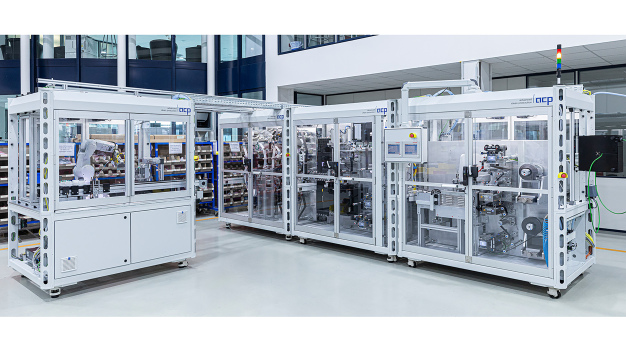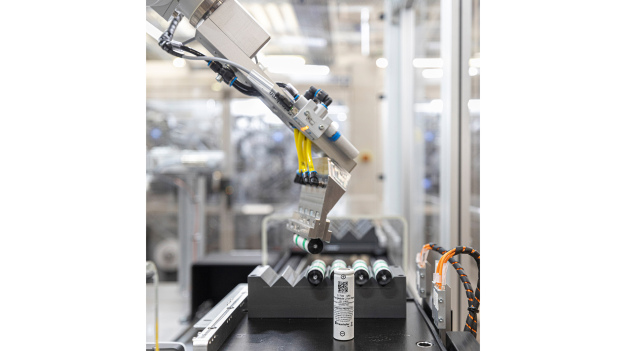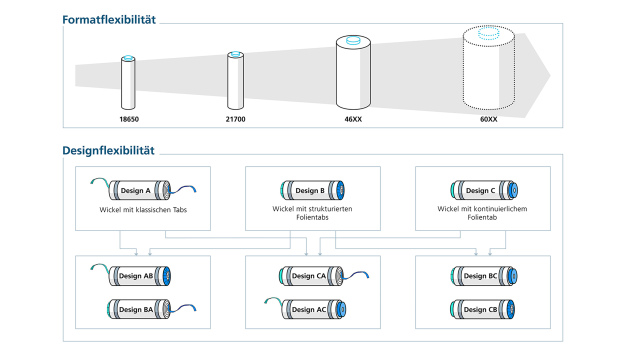- Batterie
Digitalized, Sustainable Battery Cell Production
First battery cell winding system of its kind
The further development and evolution of existing storage systems is a key prerequisite for the energy transition. The Center for Digitalized Battery Cell Manufacturing (ZDB) at the Fraunhofer Institute for Manufacturing Engineering and Automation IPA and acp systems AG have joined forces to commission a winding system for cylindrical battery cells featuring flexible formats and design. It serves as an innovative research and production platform to test new cell formats and components along with tab designs and also enables development of large-format cells for future battery technologies. The winding system is the first of its kind in the world. It is embedded in an automated, digitalized battery cell production infrastructure.
Electric vehicle batteries consist of multiple modules, each one comprising many individual battery cells. These modules are the centerpiece of any battery and are responsible for the lion’s share of value creation. Cylindrical battery cells have grown more and more popular in the automotive industry in recent years, with the trend favoring large cell formats. ZDB at Fraunhofer IPA and acp systems AG worked together closely to develop, construct, and now commission a winding system for cylindrical battery cells, also known as round cells. It will serve as a versatile research and production platform for rapid testing of new cell formats and tab designs as well as advanced methods of enhancing quality and optimizing processes. The new winding system completes a production line unlike any other in Europe for the manufacturing of cylindrical battery cells for lithium-ion batteries and future battery technologies such as sodium-ion batteries. The special feature of the production chain is that all of the process steps are digitalized and interconnected, from coating and winding to assembly, filling, and forming. The Baden-Württemberg Ministry of Economic Affairs, Labour and Tourism provided funding for the construction and installation of the winding system.
“At ZDB, we can cover all of the process steps involved in manufacturing a battery cell. The winding process is one of the core processes in cylindrical cell production, as the jelly roll is the centerpiece of the battery cell. By bringing the winding system online, we have closed a gap in the fully digitalized process chain, so the production line is complete,” says Julian Grimm, head of the research team at Fraunhofer IPA and Deputy Head of ZDB.
Electrodes and separators rolled up into jelly rolls
There are about a dozen work steps involved in getting a cell ready for use. During the winding process, the positive and negative electrodes are rolled up together with two separators to form a jelly roll. After that, the battery is assembled, a step that requires the jelly roll to be moved and positioned with great accuracy. A rod electrode is then inserted through the central hole in the roll and used to weld the roll to the base of the cylinder.
But the new winding system for cylindrical battery cells is more than just a production platform for jelly rolls. It will also serve as a research platform for developing innovative cell systems and formats and testing their quality. “What makes our system unique is its flexibility. It allows us to realize different cell formats in different sizes and tab designs, such as tabless designs, which don’t have a tab welded onto them. The tab, a narrow terminal element on the anode and cathode that the electricity has to flow through, is the chokepoint in large-format cells,” Grimm says. In round cells, the trend is toward larger cell formats, which take up more space in terms of both diameter and height. This means the roll and the cell itself end up being larger. But the issue is that the larger the cells are, the more difficult it is to collect the current and dissipate heat. “We can respond to this challenge with individual tab designs. In a tabless design, for example, the carrier foil made of aluminum and copper can serve to collect current and dissipate heat, enabling greater conduction of both than a traditional tab,” Grimm explains. Innovative cell designs ensure homogeneity in cylindrical cells, allowing for large cell formats. Larger cells with more active material can be used to achieve greater energy density, which in turn extends the range of electric vehicles.
Data collection associated with battery cells
To minimize waste and improve quality, the entire production process is digitalized and interconnected. To that end, sensors collect data, which is then aggregated in real time in the cloud. Traceability technologies developed at Fraunhofer IPA make it possible to associate the data collected with the battery cells produced. Each and every individual battery cell produced is available for data analyses and to train artificial intelligence. In this way, it is possible to trace the conditions under which the cell was produced and determine how they relate to the final product quality. The data is used to develop services with monitoring, analysis, and predictive capabilities. This makes it possible to improve the production process and eliminate sources of error faster than before.
“Innovative cell designs require redesign and optimization of production processes, which we can study using the winding system. The combination of innovative cell design and agile approaches to production is the key to meeting the requirements of a rapidly changing energy landscape, enabling faster market launches of new solutions, and paving the way forward for sustainable, high-quality battery technologies,” Grimm says. Manufacturers and users of electrodes, separators, and cells can also use the system to test their prototypes, products, cell components, materials, and designs.
![]()
Fraunhofer-Institut für Produktionstechnik und Automatisierung IPA
Nobelstraße 12
70569 Stuttgart
Germany
Phone: +49 711 970 1667
email: joerg-dieter.walz@ipa.fraunhofer.de
Internet: http://www.ipa.fraunhofer.de











